麦肯锡—三星竞争对手分析(NOKIA)
合集下载
麦肯锡:三星竞争对手分析英文版)
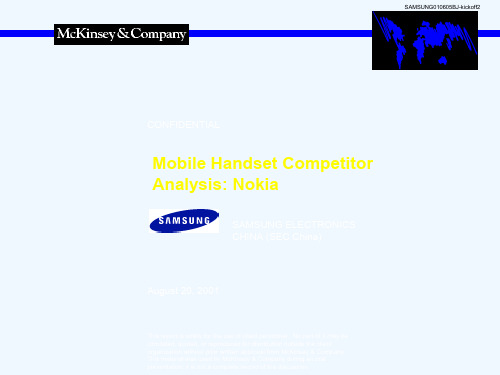
differentiate itself from its competitors?
• How does its current market position help achieve its goal? • What is Nokia’s key product offerings and how does Nokia
• Key product offerings • Key customers • Value proposition • Geographic focus • Pricing
6. Financial performance
• Sales • Profit
1
KEY ISSUES TO PROBE - NOKIA
• What is Nokia’s performance trend?
2
BACKGROUND INFORMATION
1. Background information
• Location
• Starting year
• Registered • Number of
capital
employees
differentiate its products from its competitors’?
• What customer segments is Nokia targeting at? • In which geographic areas is Nokia strong or weak? • How does Nokia’s product development meet customer requirement? • How do Nokia’s distribution channels differ from its competitors’? • Why does Nokia launch exclusive specialist shops? • How does Nokia provide customer services? • How much does Nokia invest in JVs and WOFEs in China, and what
• How does its current market position help achieve its goal? • What is Nokia’s key product offerings and how does Nokia
• Key product offerings • Key customers • Value proposition • Geographic focus • Pricing
6. Financial performance
• Sales • Profit
1
KEY ISSUES TO PROBE - NOKIA
• What is Nokia’s performance trend?
2
BACKGROUND INFORMATION
1. Background information
• Location
• Starting year
• Registered • Number of
capital
employees
differentiate its products from its competitors’?
• What customer segments is Nokia targeting at? • In which geographic areas is Nokia strong or weak? • How does Nokia’s product development meet customer requirement? • How do Nokia’s distribution channels differ from its competitors’? • Why does Nokia launch exclusive specialist shops? • How does Nokia provide customer services? • How much does Nokia invest in JVs and WOFEs in China, and what
麦肯锡—三星竞争对手分析NOKIA

differentiate itself from its competitors?
• How does its current market position help achieve its goal? • What is Nokia’s key product offerings and how does Nokia
Product
Strategy
• Focuses on mobile communication
products and aims to be a total solution
provider in mobile communication
• Regularly introduces consumer-
Source: Nokia Press Release
Implication
• Leader in mobile communication
globally and in China
• Al though a relatively later-
comer to China, has invested heavily in its Chinese business
differentiate its products from its competitors’?
• What customer segments is Nokia targeting at? • In which geographic areas is Nokia strong or weak? • How does Nokia’s product development meet customer requirement? • How do Nokia’s distribution channels differ from its competitors’? • Why does Nokia launch exclusive specialist shops? • How does Nokia provide customer services? • How much does Nokia invest in JVs and WOFEs in China, and what
• How does its current market position help achieve its goal? • What is Nokia’s key product offerings and how does Nokia
Product
Strategy
• Focuses on mobile communication
products and aims to be a total solution
provider in mobile communication
• Regularly introduces consumer-
Source: Nokia Press Release
Implication
• Leader in mobile communication
globally and in China
• Al though a relatively later-
comer to China, has invested heavily in its Chinese business
differentiate its products from its competitors’?
• What customer segments is Nokia targeting at? • In which geographic areas is Nokia strong or weak? • How does Nokia’s product development meet customer requirement? • How do Nokia’s distribution channels differ from its competitors’? • Why does Nokia launch exclusive specialist shops? • How does Nokia provide customer services? • How much does Nokia invest in JVs and WOFEs in China, and what
178 麦肯锡—三星竞争对手分析清华汉魅

3. Product/market
• Key product offerings • Key customers • Value proposition • Geographic focus • Pricing
6. Financial performance
• Sales • Profit
3
SAMSUNG010605BJ-kickoff2
are the main drivers?
• How does Nokia organize to enable the JVs and WOFEs to work
together?
• How strong is Nokia’s performance and what are the major
contributors?
SAMSUNG010605BJ-kickoff2
CONFIDENTIAL
Mobile Handset Competitor Analysis: Nokia
SAMSUNG ELECTRONICS CHINA (SEC China)
August 20, 2019
This report is solely for the use of client personnel. No part of it may be circulated, quoted, or reproduced for distribution outside the client organization without prior written approval from McKinsey & Company. This material was used by McKinsey & Company during an oral presentation; it is not a complete record of the discussion.
麦肯锡_三星竞争对手分析(nokia)
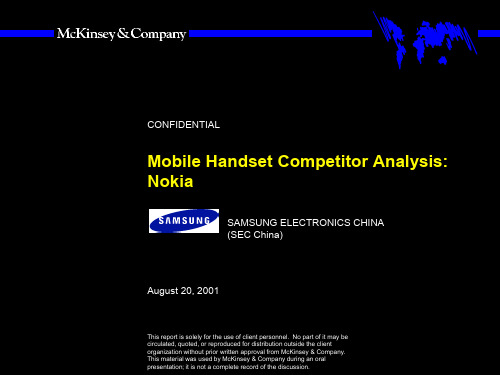
Source: Nokia Press Release
Implication
• Leader in mobile communication
globally and in China
• Al though a relatively later-
comer to China, has invested heavily in its Chinese business
1986
• Supplied transmission system, optical cable and
electric cables in later 1980s
• Supplied analog ETACS system and terminals in
1989
• Supplied GSM system and terminals in 1990s
• Management • Era analysis
team
• Equity
structure
4. Value chain strategy
• Focus on
– Marketing, advertising and promotion
– Distribution (channel and sales force)
SAMSUNG010605BJ-kickoff2
2. Strategy
• Mission • Vision • Corporate strategy • Market position
5. Organization and ownership
• Organization structure • Ownership structure
麦肯锡三星战略2nokia精品文档
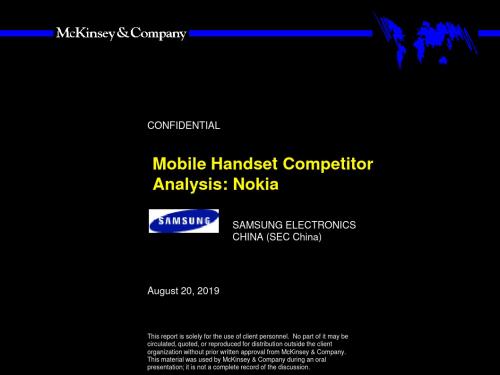
• Focus on
– Marketing, advertising and promotion
– Distribution (channel and sales force)
SAMSUNG010605BJ-kickoff2
2. Strategy
• Mission • Vision • Corporate strategy • Market position
6. Financial performance
• Sales • Profit
5
SAMSUNG010605BJ-kickoff2
NOKIA POSITIONS ITSELF AS A LEADING PRODUCT AND SYSTEM SUPPLIER IN THE FAST GROWING MOBILE COMMUNICATION INDUSTRY
team
• Equity
structure
4. Value chain strategy
Focus on
• Marketing,
advertising and promotion
• Distribution (channel
and sales force)
SAMSUNG010605BJ-kickoff2
1986
• Supplied transmission system, optical cable and
electric cables in later 1980s
• Supplied analog ETACS system and terminals in
1989
• Supplied GSM system and terminals in 1990s
– Marketing, advertising and promotion
– Distribution (channel and sales force)
SAMSUNG010605BJ-kickoff2
2. Strategy
• Mission • Vision • Corporate strategy • Market position
6. Financial performance
• Sales • Profit
5
SAMSUNG010605BJ-kickoff2
NOKIA POSITIONS ITSELF AS A LEADING PRODUCT AND SYSTEM SUPPLIER IN THE FAST GROWING MOBILE COMMUNICATION INDUSTRY
team
• Equity
structure
4. Value chain strategy
Focus on
• Marketing,
advertising and promotion
• Distribution (channel
and sales force)
SAMSUNG010605BJ-kickoff2
1986
• Supplied transmission system, optical cable and
electric cables in later 1980s
• Supplied analog ETACS system and terminals in
1989
• Supplied GSM system and terminals in 1990s
070麦肯锡_三星竞争对手分析
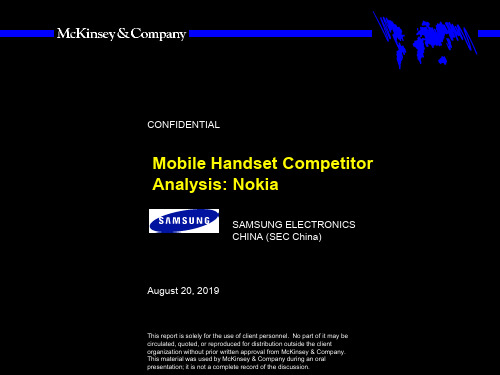
SAMSUNG010605BJ-kickoff2
CONFIDENTIAL
Mobile Handset Competitor Analysis: Nokia
SAMSUNG ELECTRONICS CHINA (SEC China)
August 20, 2019
This report is solely for the use of client personnel. No part of it may be circulated, quoted, or reproduced for distribution outside the client organization without prior written approval from McKinsey & Company. This material was used by McKinsey & Company during an oral presentation; it is not a complete record of the discussion.
are the main drivers?
• How does Nokia organize to enable the JVs and WOFEs to work
together?
• How strong is Nokia’s performance and what are the major
contributors?
OVERVIEW OF COMPETITOR ANALYSIS FRAMEWORK
1. Background information
• Location
• Starting year
CONFIDENTIAL
Mobile Handset Competitor Analysis: Nokia
SAMSUNG ELECTRONICS CHINA (SEC China)
August 20, 2019
This report is solely for the use of client personnel. No part of it may be circulated, quoted, or reproduced for distribution outside the client organization without prior written approval from McKinsey & Company. This material was used by McKinsey & Company during an oral presentation; it is not a complete record of the discussion.
are the main drivers?
• How does Nokia organize to enable the JVs and WOFEs to work
together?
• How strong is Nokia’s performance and what are the major
contributors?
OVERVIEW OF COMPETITOR ANALYSIS FRAMEWORK
1. Background information
• Location
• Starting year
麦肯锡—三星竞争对手分析(NOKIA)-31页文档资料

• Key product offerings • Key customers • Value proposition • Geographic focus • Pricing
6. Financial performance
• Sales • Profit
1
KEY ISSUES TO PROBE - NOKIA
3. Product/market
• Key product offerings • Key customers • Value proposition • Geographic focus • Pricing
6. Financial performance
• Sales • Profit
3
SAMSUNG010605BJ-kickoff2
mobile
• First office in China in 1985, first JV in China in 1994
Employees History
• 60,000 staff in 130 countries • More than 20 offices in China, 7 JVs, 1 WOFE and 1
OVERVIEW OF COMPETITOR ANALYSIS FRAMEWORK
1. Background information
• Location
• Starting year
• Registered • Number of
capital
employees
• Management • Era analysis
oriented products with emphasis on
designs and functions
6. Financial performance
• Sales • Profit
1
KEY ISSUES TO PROBE - NOKIA
3. Product/market
• Key product offerings • Key customers • Value proposition • Geographic focus • Pricing
6. Financial performance
• Sales • Profit
3
SAMSUNG010605BJ-kickoff2
mobile
• First office in China in 1985, first JV in China in 1994
Employees History
• 60,000 staff in 130 countries • More than 20 offices in China, 7 JVs, 1 WOFE and 1
OVERVIEW OF COMPETITOR ANALYSIS FRAMEWORK
1. Background information
• Location
• Starting year
• Registered • Number of
capital
employees
• Management • Era analysis
oriented products with emphasis on
designs and functions
麦肯锡—三星竞争对手分析NOKIA清华汉魅

differentiate itself from its competitors?
• How does its current market position help achieve its goal? • What is Nokia’s key product offerings and how does Nokia
NOKIA IS RELATIVELY A LATE-COMER TO CHINA; HOWEVER IT HAS GROWN RAPIDLY TO BECOME A MARKET LEADER IN MOBILE COMMUNICATION
Background Location
• Based at Finland, with offices in China, e.g. Beijing • China is Nokia's strategic location because it is
are the main drivers?
• How does Nokia organize to enable the JVs and WOFEs to work
together?
• How strong is Nokia’s performance and what are the major
contributors?
• What is Nokia’s performance trend?
2
BACKGROUND INFORMATION
1. Background information
• Location
• Starting year
• Registered • Number of
capital
• How does its current market position help achieve its goal? • What is Nokia’s key product offerings and how does Nokia
NOKIA IS RELATIVELY A LATE-COMER TO CHINA; HOWEVER IT HAS GROWN RAPIDLY TO BECOME A MARKET LEADER IN MOBILE COMMUNICATION
Background Location
• Based at Finland, with offices in China, e.g. Beijing • China is Nokia's strategic location because it is
are the main drivers?
• How does Nokia organize to enable the JVs and WOFEs to work
together?
• How strong is Nokia’s performance and what are the major
contributors?
• What is Nokia’s performance trend?
2
BACKGROUND INFORMATION
1. Background information
• Location
• Starting year
• Registered • Number of
capital
:《某咨询—三星竞争对手分析(NOKIA)ppt》

SAMSUNG010605BJ-kickoff2
2. Strategy
• Mission • Vision • Corporate strategy • Market position
5. Organization and ownership
• Key product offerings • Key customers • Value proposition • Geographic focus • Pricing
6. Financial performance
• Sales • Profit
1
KEY ISSUES TO PROBE - NOKIA
differentiate its products from its competitors’?
• What customer segments is Nokia targeting at? • In kia strong or weak? • How does Nokia’s product development meet customer
SAMSUNG010605BJ-kickoff2
Strategy
Product/market
Value chain strategy
Organization & ownership
Financial performance
• How does Nokia position itself now and in 2005? • What are Nokia’s product and value delivery system strategies that
• Management • Era analysis
麦肯锡—三星竞争对手分析NOKIA清华汉魅参考幻灯片
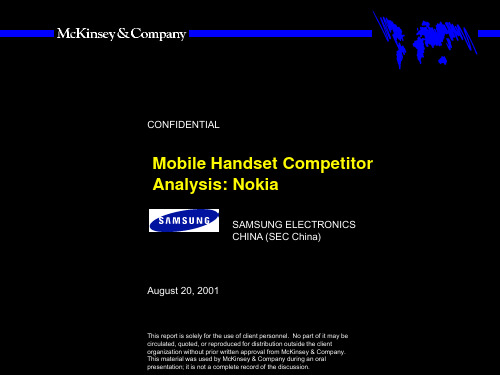
• Management • Era analysis
te. Value chain strategy
• Focus on
– Marketing, advertising and promotion
– Distribution (channel and sales force)
• How does its current market position help achieve its goal? • What is Nokia’s key product offerings and how does Nokia
differentiate its products from its competitors’?
2. Strategy
• Mission • Vision • Corporate strategy • Market position
5. Organization and ownership
• Organization structure • Ownership structure
3. Product/market
are the main drivers?
• How does Nokia organize to enable the JVs and WOFEs to work
together?
• How strong is Nokia’s performance and what are the major
contributors?
• What is Nokia’s performance trend?
2
BACKGROUND INFORMATION
1. Background information
070麦肯锡_三星竞争对手分析(NOKIA)-PPT文档资料30页

1. Background information
• Location
• Starting year
• Registered • Number of
capital
employees
• Management • Era analysis
team
• Equity
structure
4. Value chain strategy
• Key product offerings • Key customers • Value proposition • Geographic focus • Pricing
6. Financial performance
• Sales • Profit
1
KEY ISSUES TO PROBE - NOKIA
SAMSUNG010605BJ-kickoff2
CONFIDENTIAL
Mobile Handset Competitor Analysis: Nokia
SAMSUNG ELECTRONICS CHINA (SEC China)
August 20, 2019
This report is solely for the use of client personnel. No part of it may be circulated, quoted, or reproduced for distribution outside the client organization without prior written approval from McKinsey & Company. This material was used by McKinsey & Company during an oral presentation; it is not a complete record of the discussion.
麦肯锡—三星竞争对手分析(nokia)

• Management • Era analysis
team
• Equity
structure
4. Value chain strategy
• Focus on
– Marketing, advertising and promotion
– Distribution (channel and sales force)
mobile
• First office in China in 1985, first JV in China in 1994
Employees History
• 60,000 staff in 130 countries • More than 20 offices in China, 7 JVs, 1 WOFE and 1
• Focus on
– Marketing, advertising and promotion
– Distribution (channel and sales force)
SAMSUNG010605BJ-kickoff2
2. Strategy
• Mission • Vision • Corporate strategy • Market position
including rural areas
Vision
To lead mobile communication through the integration of mobility with internet and the innovation of new service models
Source: Nokia press Release
oriented products with emphasis on
三星竞争对手分析(NOKIA)

R&D center with over 5500 staff
Employees
History
• Started business in China since 1950s • 1985 saw first office in Beijing, supplying fixed line
networks
• Location • Registered
capital team Equity structure
• Starting year • Number of
employees
• Focus on
– Marketing, advertising and promotion – Distribution (channel and sales force)
• Management • Era analysis •
2. Strategy
5. Organization and ownership
• • • •
Mission Vision Corporate strategy Market position
• Organization structure • Ownership structure
Starting
• First office in China in 1985, first JV in China in 1994 • 60,000 staff in 130 countries • More than 20 offices in China, 7 JVs, 1 WOFE and 1
• Supplied analog NMT 450 system and terminal in
1986
Employees
History
• Started business in China since 1950s • 1985 saw first office in Beijing, supplying fixed line
networks
• Location • Registered
capital team Equity structure
• Starting year • Number of
employees
• Focus on
– Marketing, advertising and promotion – Distribution (channel and sales force)
• Management • Era analysis •
2. Strategy
5. Organization and ownership
• • • •
Mission Vision Corporate strategy Market position
• Organization structure • Ownership structure
Starting
• First office in China in 1985, first JV in China in 1994 • 60,000 staff in 130 countries • More than 20 offices in China, 7 JVs, 1 WOFE and 1
• Supplied analog NMT 450 system and terminal in
1986
麦肯锡—三星竞争对手分析(NOKIA)英文
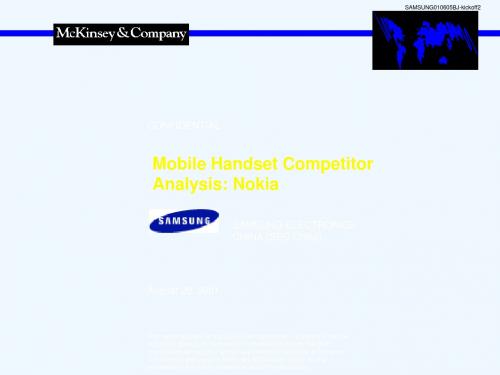
• • • •
Mission Vision Corporate strategy Market position
• Organization structure • Ownership structure
3. Product/market
6. Financial performance
• • • • •
• Location • Registered
capital team
• Starting year • Number of
employees
• Focus on
– Marketing, advertising and promotion – Distribution (channel and sales force)
Product
Vision To lead mobile communication through the integration of mobility with internet and the innovation of new service models
Starting
• First office in China in 1985, first JV in China in 1994
• 60,000 staff in 130 countries • More than 20 offices in China, 7 JVs, 1 WOFE and 1
• Management • Era analysis • Equity
structure
2. Strategy
5. Organization and ownership
பைடு நூலகம்
• • • •
- 1、下载文档前请自行甄别文档内容的完整性,平台不提供额外的编辑、内容补充、找答案等附加服务。
- 2、"仅部分预览"的文档,不可在线预览部分如存在完整性等问题,可反馈申请退款(可完整预览的文档不适用该条件!)。
- 3、如文档侵犯您的权益,请联系客服反馈,我们会尽快为您处理(人工客服工作时间:9:00-18:30)。
Starting
• First office in China in 1985, first JV in China in 1994 • 60,000 staff in 130 countries • More than 20 offices in China, 7 JVs, 1 WOFE and 1
Product
Vision To lead mobile communication through the integration of mobility with internet and the innovation of new service models
• Location • Registered
capital team Equity structure
• Starting year • Number of
employees
• Management • Era analysis •
2. Strategy
5. Organization and ownership
R&D center with over 5500 staff
Employees
History
• Started business in China since 1950s • 1985 saw first office in Beijing, supplying fixed line
networks
• How does Nokia position itself now and in 2005? • What are Nokia’s product and value delivery system strategies that
differentiate itself from its competitors? • How does its current market position help achieve its goal? • What is Nokia’s key product offerings and how does Nokia differentiate its products from its competitors’? • What customer segments is Nokia targeting at? • In which geographic areas is Nokia strong or weak? • How does Nokia’s product development meet customer requirement? • How do Nokia’s distribution channels differ from its competitors’? • Why does Nokia launch exclusive specialist shops? • How does Nokia provide customer services? • How much does Nokia invest in JVs and WOFEs in China, and what are the main drivers? • How does Nokia organize to enable the JVs and WOFEs to work together? • How strong is Nokia’s performance and what are the major contributors? • What is Nokia’s performance trend?
Product/market
Value chain strategy
Organization & ownership
Financial performance
2
SAMSUNG010605BJ-kickoff2
BACKGROUND INFORMATION
1. Background information 4. Value chain strategy
mobile
• Al though a relatively latercomer to China, has invested heavily in its Chinese business
Business
• Focused product lines with
Nokia network offering mobile, broadband and IP network infrastructure, and Nokia mobile offering mobile handsets
• • • •
Mission Vision Corporate strategy Market position
• Organization structure • Ownership structure
3. Product/market
6. Financial performance
• • • • •
3. Product/market
6. Financial performance
• • • • •
Key product offerings Key customers Value proposition Geographic focus Pricing
• Sales • Profit
3
SAMSUNG010605BJ-kickoff2
6. Financial performance
• • • • •
Key product offerings Key customers Value proposition Geographic focus Pricing
• Sales • Profit
5
SAMSUNG010605BJ-kickoff2
• Supplied analog NMT 450 system and terminal in
1986
• Supplied transmission system, optical cable and • •
electric cables in later 1980s Supplied analog ETACS system and terminals in 1989 Supplied GSM system and terminals in 1990s 4
• Starting year • Number of
employees
• Focus on
– Marketing, advertising and promotion – Distribution (channel and sales force)
• Management • Era analysis •
SAMSUNG010605BJ-kickoff2
OVERVIEW OF COMPETITOR ANALYSIS FRAMEWORK
1. Background information 4. Value chain strategy Focus on • Marketing, advertising and promotion • Distribution (channel and sales force)
• Based at Finland, with offices in China, e.g. Beijing • China is Nokia's strategic location because it is
Nokia's second largest market, second only to US
NOKIA IS RELATIVELY A LATE-COMER TO CHINA; HOWEVER IT HAS GROWN RAPIDLY TO BECOME A MARKET LEADER IN MOBILE COMMUNICATION
Background Location Implication
• Leader in mobile communication
globally and in China
Investment
• Invested more than USD1.7 billion in China • Two main business units: Nokia network and Nokia
2. Strategy
5. Organization and ownership
• • • •
Mission Vision Corporate strategy Market position
• Organization structure • Ownership structure
3. Product /market
• Location • Registered
capital team Equity structure
• Starting year • Number of
employees
• Focus on
– Marketing, advertising and promotion – Distribution (channel and sales force)
Key product offerings Key customers Value proposition Geographic focus Pricing
• Sales • Profit
1
SAMSUNG010605BJ-kickoff2
KEY ISSUES TO PROBE - NOKIA
Strategy
Source: Nokia Press Release
SAMSUNG010605BJ-kickoff2
